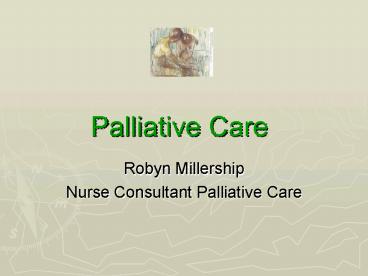Palliative Care - PowerPoint PPT Presentation
1 / 22
Title:
Palliative Care
Description:
Palliative Care. Robyn Millership. Nurse Consultant Palliative Care. W.H.O. 1990 ... the active total care of people whose illness is not responsive to curative ... – PowerPoint PPT presentation
Number of Views:401
Avg rating:3.0/5.0
Title: Palliative Care
1
Palliative Care
- Robyn Millership
- Nurse Consultant Palliative Care
2
What is Palliative Care ?
- the active total care of people whose illness
is not responsive to curative treatment. - Care is delivered by coordinated medical,
nursing and allied health professionals which is
provided, where possible, in the environment of
the persons choice . - Control of pain, of other symptoms and provision
of psychological, social, emotional and spiritual
support is paramount.
3
What Is Palliative Care ? (2)
- Not just patients with cancer
- 80 hospice pts have primary diagnosis of
cancer - Includes pain and other symptom control as well
as social, psychological and spiritual care. - The goal is to achieve the best possible quality
of life.
4
Core Values of Palliative Care
- The dignity of the patient and their family
- Compassionate care of the patient and family
- Equity in access to palliative care services
- Empowerment of the patient, family caregiver to
manage their own situation - Respect for the patient, family and carers
- Advocacy on behalf of the expressed wishes of
patients and family. - Pursuit of excellence in the provision of care
and support
5
Palliative Care
- Affirms life and regards dying as a normal
process - Neither hastens nor postpones death
- Provides relief from pain and other distressing
symptoms - Integrates the psychological and spiritual
aspects of care - Offers a support system to patients and families
6
Palliative Care Is Not Just About Death and Dying
- Palliative Care Is About Life and Living
7
Where is it delivered ?
- The triangle of care is the basic model
- Home (community services)
- Hospitals (consultative services)
- Hospice
- Model is expanding
- Day hospice model evolving
- Outpatient clinics
- Acute subacute beds
- Role of greater collaboration with acute care
units
8
When is Palliative Care needed ?
The disease or illness is considered to be
incurable. The disease recurs. The disease is
increasingly unresponsive to treatment. For
symptom assessment and /or control at any stage
of the illness For carer support in the setting
of progressive illness. Often, the point at
which the decision is made is variable and
uncertain, and influenced by the needs of patient
and family.
9
Who needs palliative care ?
Patients who have symptoms associated with the
disease or treatment regardless of the
prognosis. Patients who wish to die at
home. Patients who require in-patient terminal
care. Carers who required support or symptom
control in the home setting.
10
How is palliative care provided ?
By assessing and addressing Physical
symptoms Social networks and support Spiritua
l preferences Psychological responses Cultura
l needs
11
Physical domain
- Assessment
- Goal centred care
- Symptom management, including pain, nausea,
vomiting, constipation etc etc - Assistance with activities of daily living,
including appropriate home aides
12
Spiritual Domain
- the spiritual dimensions of the patient and
family are acknowledged, explored and responded
to appropriately. - the religious beliefs of the patient and family
are recognised and respected. - appropriate spiritual and religious support for
patients, families and care - Palliative Care Australia
- Standards for Palliative Care Provision
- It is often necessary to hear the life story of a
person to enable them to begin the transition to
the next phase of life
13
Psychological Domain
- Assessment and response to the psychological
impact of the terminal illness - Referral to a specialist for expert advice or
when emotional needs cannot be met - Availability of a bereavement program that is
evidence and needs based - Recognition of the impact of staff providing this
type of care to patients and families - Palliative care Australia
- Standards for palliative care
14
Social domain
- Feeling of acceptance
- Practically arranging affairs
- Financial matters
- Family concerns
15
Cultural domain
- Services meet the cultural needs of the patient
and family and reflects the diversity of the
community - The staff mix resembles the community population
16
Structural standards
- Care is interdisciplinary
- Specialist education in palliative care is
provided - Commitment to quality improvement
17
Palliative Care Multidisciplinary
Teams(includes the patient and family)
- Art therapist
- Music therapist
- Massage therapist
- Reiki therapist
- Teaching centre (students)
- Nurses
- Doctors
- Social workers
- Pastoral care workers
- Clinical psychologists
- Psychiatrists
- Physiotherapists
- Occupational therapists
- Volunteers
18
Reasons for Admission to Hospice
- Symptom management, including pain, nausea, etc
- Respite family and/or patient
- Often results in terminal care
- End-of-life care
- Limited Rehabilitation
- In-depth psycho-social assessment support
19
Causes of Distress in End of Life Care
- Physical functioning difficult with mobility,
sleep, appetite, eating, energy, fatigue - Physical integrity nausea, pain, breathing, sore
mouth, physical appearance, CONSTIPATION - Emotional well-being mood disorders, anxiety,
depression, fear of dying process, anger, outlook
20
Causes of Distress in End of Life Care
- Social relationships ability to undertake
leisure activities, social activities - Illness adaptation coming to terms with illness,
advancement - Economic/occupational for family, funeral
- Cognitive ability difficulty with
concentration/memory
21
Focus of Care
- Assessment
- Symptom control
- Evaluation of care goals and objectives
- Spiritual and psychosocial care
- Communication and lots of it!
22
Future Directions
- Incorporation of palliative care principles and
practice into a broader range of settings - Encourage introduction of palliative care to
patients and families before the terminal phase
of illness - Encourage a parallel course of care rather than
exhausting one and seeing palliative care as a
last resort - Promote awareness of palliative care for all
health professionals































